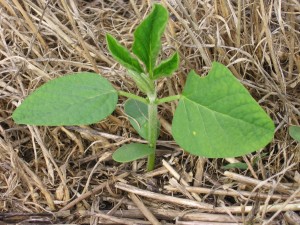My usually answer to this question is “No…at least not on a big part of your acreage.” But, let’s rephrase the question to “Can you plant soybean in April?” The answer is clearly “Yes, you can…but don’t plant the entire farm in April.” Below, I’ll discuss the reasons for these answers.
What are the advantages to planting in April? One advantage is that the crop mature earlier. A general rule of thumb is that planting 30 days earlier will allow you to harvest about 10 days earlier? Only you can decide if harvesting 10 days earlier is an advantage though. So, ask yourself if this fits into your operation.
You can also gain another 10 or so days by selecting a variety that is at least a full maturity group earlier (e.g., MG 4.5 instead of a 5.5, or a 3.7 instead of a 5.0). You’ve then changed your systems substantially. Such a system is commonly referred to as the Early Soybean Production System (ESPS), which is now the most common soybean production system in the Mid-South/Delta growing region of the country.
But choosing an earlier variety and/or planting early is not just about harvesting earlier. You will also place the most critical time of soybean development (pod and seed fill) earlier in the season. For the Mid-South that regularly experiences drought in August, the ESPS puts those critical stages into July and early August; thereby avoiding the driest (and maybe hottest) time of the year. In addition, this system captures more sunlight per day during the pod and seed development stages (i.e., the days are longer in July than in August which are longer than in September), With more photosynthesis per day during these stages, we can gain yield potential. Early planting was also found to be beneficial in the Midwest; I suspect that the longer days were the primary benefit there. So theoretically, yield potential is greater with early planting of early-maturing varieties, even if drought in August is not the major concern.
Although similar benefits are possible in Virginia, planting early with an early-maturing variety can result in lower yields. Why? First, droughts in Virginia are intermittent. In some years, August is our driest month, in others it is July or June or September or…. Furthermore, most of our soils hold very little water. In some soils, we are 10 days from the last rainfall to a drought. Add to this that the hottest and usually driest time is late-July and early-August, and you have a recipe for disaster with early planting and/or early maturity groups.
But, what if you irrigate? These are the fields that I would use an early soybean production system. A high plant-available water-holding capacity soil also helps. At least you can avoid the drought stress. And because the season is naturally shorter, you will likely spend less on irrigation. But, there is still the heat risk. Only time will tell if the benefits outweigh the risks. Even in irrigated fields, you may only want to dedicate a small portion of your acreage to an early system.
A final risk from planting early is seedling diseases. It may take 2 to 3 weeks for soybean to emerge if planted in April. So, be sure to use a fungicide seed treatment.
In summary, there may be benefits to planting early and/or using earlier-maturing varieties. But, I think that the risks outweigh the benefits, especially in rainfed conditions.

